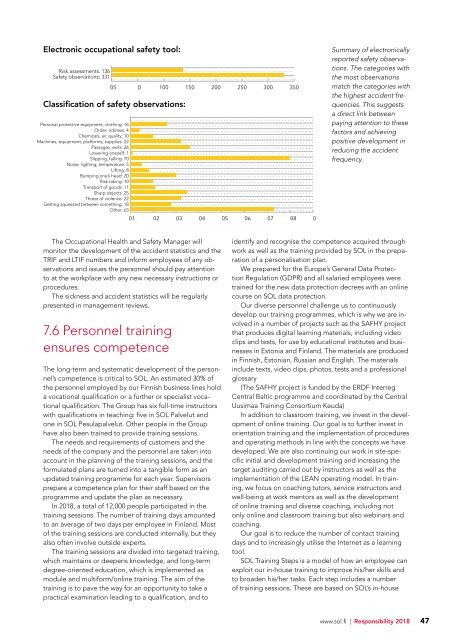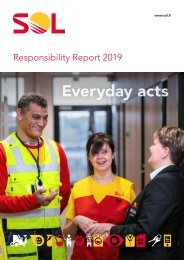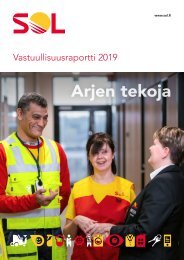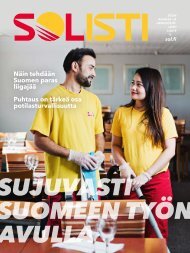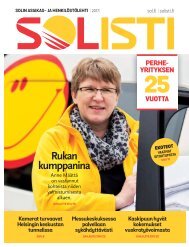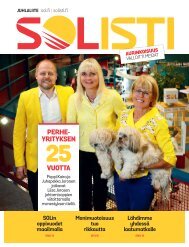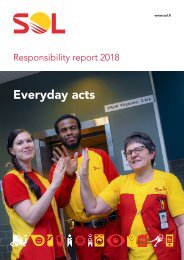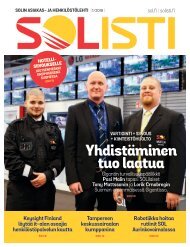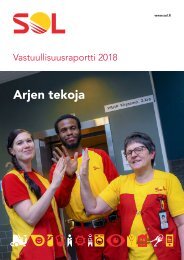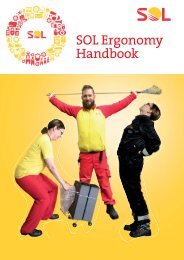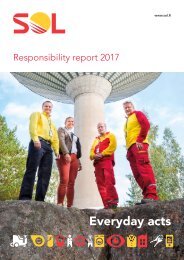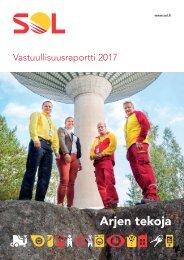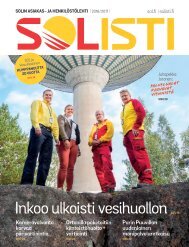SO Responsibilityreport_2018
Create successful ePaper yourself
Turn your PDF publications into a flip-book with our unique Google optimized e-Paper software.
Electronic occupational safety tool:<br />
Risk assessments: 136<br />
Safety observations: 331<br />
Classification of safety observations:<br />
Personal protective equipment, clothing: 16<br />
Order, tidiness: 4<br />
Chemicals, air quality: 10<br />
Machines, equipment, platforms, supplies: 22<br />
Passages, exits: 26<br />
Lowering oneself: 1<br />
Slipping, falling: 70<br />
Noise, lighting, temperature: 5<br />
Lifting: 8<br />
Bumping one’s head: 20<br />
Risk taking: 10<br />
Transport of goods: 11<br />
Sharp objects: 25<br />
Threat of violence: 22<br />
Getting squeezed between something: 18<br />
Other: 63<br />
05 0 100 150 200 250 300 350<br />
01 02 03 04 05 06 07 08 0<br />
Summary of electronically<br />
reported safety observations.<br />
The categories with<br />
the most observations<br />
match the categories with<br />
the highest accident frequencies.<br />
This suggests<br />
a direct link between<br />
paying attention to these<br />
factors and achieving<br />
positive development in<br />
reducing the accident<br />
frequency.<br />
The Occupational Health and Safety Manager will<br />
monitor the development of the accident statistics and the<br />
TRIF and LTIF numbers and inform employees of any observations<br />
and issues the personnel should pay attention<br />
to at the workplace with any new necessary instructions or<br />
procedures.<br />
The sickness and accident statistics will be regularly<br />
presented in management reviews.<br />
7.6 Personnel training<br />
ensures competence<br />
The long-term and systematic development of the personnel’s<br />
competence is critical to <strong>SO</strong>L. An estimated 30% of<br />
the personnel employed by our Finnish business lines hold<br />
a vocational qualification or a further or specialist vocational<br />
qualification. The Group has six full-time instructors<br />
with qualifications in teaching: five in <strong>SO</strong>L Palvelut and<br />
one in <strong>SO</strong>L Pesulapalvelut. Other people in the Group<br />
have also been trained to provide training sessions.<br />
The needs and requirements of customers and the<br />
needs of the company and the personnel are taken into<br />
account in the planning of the training sessions, and the<br />
formulated plans are turned into a tangible form as an<br />
updated training programme for each year. Supervisors<br />
prepare a competence plan for their staff based on the<br />
programme and update the plan as necessary.<br />
In <strong>2018</strong>, a total of 12,000 people participated in the<br />
training sessions. The number of training days amounted<br />
to an average of two days per employee in Finland. Most<br />
of the training sessions are conducted internally, but they<br />
also often involve outside experts.<br />
The training sessions are divided into targeted training,<br />
which maintains or deepens knowledge, and long-term<br />
degree-oriented education, which is implemented as<br />
module and multiform/online training. The aim of the<br />
training is to pave the way for an opportunity to take a<br />
practical examination leading to a qualification, and to<br />
identify and recognise the competence acquired through<br />
work as well as the training provided by <strong>SO</strong>L in the preparation<br />
of a personalisation plan.<br />
We prepared for the Europe’s General Data Protection<br />
Regulation (GDPR) and all salaried employees were<br />
trained for the new data protection decrees with an online<br />
course on <strong>SO</strong>L data protection.<br />
Our diverse personnel challenge us to continuously<br />
develop our training programmes, which is why we are involved<br />
in a number of projects such as the SAFHY project<br />
that produces digital learning materials, including video<br />
clips and tests, for use by educational institutes and businesses<br />
in Estonia and Finland. The materials are produced<br />
in Finnish, Estonian, Russian and English. The materials<br />
include texts, video clips, photos, tests and a professional<br />
glossary<br />
(The SAFHY project is funded by the ERDF Interreg<br />
Central Baltic programme and coordinated by the Central<br />
Uusimaa Training Consortium Keuda)<br />
In addition to classroom training, we invest in the development<br />
of online training. Our goal is to further invest in<br />
orientation training and the implementation of procedures<br />
and operating methods in line with the concepts we have<br />
developed. We are also continuing our work in site-specific<br />
initial and development training and increasing the<br />
target auditing carried out by instructors as well as the<br />
implementation of the LEAN operating model. In training,<br />
we focus on coaching tutors, service instructors and<br />
well-being at work mentors as well as the development<br />
of online training and diverse coaching, including not<br />
only online and classroom training but also webinars and<br />
coaching.<br />
Our goal is to reduce the number of contact training<br />
days and to increasingly utilise the Internet as a learning<br />
tool.<br />
<strong>SO</strong>L Training Steps is a model of how an employee can<br />
exploit our in-house training to improve his/her skills and<br />
to broaden his/her tasks. Each step includes a number<br />
of training sessions. These are based on <strong>SO</strong>L’s in-house<br />
www.sol.fi | Responsibility <strong>2018</strong><br />
47


